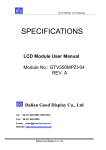Download OSD-2828OGDEDF01 EVK user guide
Transcript
OSD-2828OGDEDF01
Application note
Evaluation Kit User Guide
REVISION HISTORY
Date
2005/09/23
Page
Contents
Version
Preliminary
Preliminary
EVK Schematic
Symbol define
D0-D8:These pins are 9-bit bi-directional data bus to be connected to the MCU’s data bus.
BS1,BS2,BS3:These input pins are used to configure MCU interface selection by appropriate
logic setting, which is described in the following table. User can fixed these pins by jump (J3,
J4). Unlike BS0~2 are can control by hardware, BS3 is control by software command 0xA0
only.BS0 has already fixed to GND.
Table 1 – MCU Interface Selection Setting
E/RD#:This pin is MCU interface input. When interfacing to a 6800-series microprocessor, this
pin will be used as the Enable (E) signal. Read/write operation is initiated when this pin is
pulled high and the chip is selected.
When connecting to an 8080-microprocessor, this pin receives the Read (RD) signal. Data
read operation is initiated when this pin is pulled low and the chip is selected. When serial
interface is selected, this pin E(RD) must be connected to VSS.
R/W#:This pin is MCU interface input. When interfacing to a 6800-series microprocessor, this
pin will be used as Read/Write (R/W) selection input. Read mode will be carried out when this
pin is pulled high and write mode when low.
When 8080 interface mode is selected, this pin will be the Write (WR) input. Data write
operation is initiated when this pin is pulled low and the chip is selected. When serial interface
is selected, this pin R/W must be connected to VSS.
D/C#:This pin is Data/Command control pin. When the pin is pulled high, the data at D0-D17
is
treated as display data. When the pin is pulled low, the data at D0-D17 will be transferred to
the command register. For detail relationship to MCU interface signals, please refer to the
timing characteristics diagrams at following pages and datasheet.
RES#:This pin is reset signal input. When the pin is low, initialization of the chip is executed.
CS#:This pin is the chip select input. The chip is enabled for MCU communication only when
CS is pulled low.
VCC:This is the most positive voltage supply pin of the chip.
VDD:Power supply pin for logic operation of the driver.
GND:Power supply ground.
VDD = 2.4 to 3.5V, TA = -40 to 85°C
Table 2 6800-Series MPU Parallel Interface Timing Characteristics
Figure 1 6800-series MPU parallel interface characteristics
Note:When 9 bit used: D0 ~ D8 instead.
VDD = 2.4 to 3.5V, TA = -40 to 85°C
Table 3 8080-Series MPU Parallel Interface Timing Characteristics
Figure 2 8080-series MPU parallel interface characteristics
Note:When 9 bit used: D0 ~ D8 instead.
VDD = 2.4 to 3.5V, TA = -40 to 85°C
Table 4 Serial Interface Timing Characteristics
Figure 3 Serial interface characteristics
Figure 4 EVK PCB and OLED Module
Figure 5 the module and EVK assembled (Top view)
Because the package of OSD-2828OGDEDF01 is COF, that the connect pads are on the top of
the module, and the connector which on the EVK PCB board is double size connect type. So
when assemble the module with EVK. The module must face up first and plug into the
connector. When finished assembled the module and EVK, then push the locking pad to lock
the module. See the figure 5.
When finished assembled the module and EVK. User can use leading wire to connect EVK
with customer’s system. The example shows as figure 6.
Note1
Figure 7 control MCU connect with EVK
Note 1:It is the external most positive voltage supply. In this sample is connected to power
supply.
How to use OSD-2828OGDEDF01
Reset set
RES#=0
Delay 10ms
RES#=1
Initial IC
code
Suggest all register
set again
Display on
Clear RAM
Start send
data
RD recommends Initial Code:
void Initial_ic(void)
{
IOCLR=0xffffffff;
//data=0
IOSET=bE_RD;
IOCLR=bD_C|bR_W|bCS;
Reset_SSD1339();
write_c(0xa0);
write_d(0xb4);
write_c(0xa1);
write_d(0x00);
write_c(0xa2);
write_d(0x80);
write_c(0xA6);
write_c(0xad);
write_d(0x8e);
write_c(0xb0);
write_d(0x05);
write_c(0xb1);
write_d(0x11);
write_c(0xb3);
write_d(0xf0);
write_c(0xbb);
write_d(0x1c);
write_d(0x1c);
write_d(0x1c);
write_c(0xbe);
write_d(0x1f);
write_c(0xc1);
write_d(0xaa);
write_d(0xb4);
write_d(0xc8);
write_c(0xc7);
write_d(0x0f);
write_c(0xca);
write_d(0x7f);
write_c(0xaf);
// Set Re-map / Color Depth
// 262K 8bit
R->G->B
// Set display start line
// 00h start
// Set display offset
// 80h start
// Normal display
// Set Master Configuration
// DC-DC off & external VcomH voltage & external pre-charge voltage
// Power saving mode
// Set pre & dis_charge
// pre=1h dis=1h
// clock & frequency
// clock=Divser+1 frequency=fh
// Set pre-charge voltage of color A B C
// color A
// color B
// color C
// Set VcomH
//
// Set contrast current for A B C
// Color A
// Color B
// Color C
// Set master contrast
// no change
// Duty
// 127+1
// Display on
}
void Reset_SSD1339(void)
{
IOCLR=bRES;
Delay_1ms(100);
IOSET=bRES;
}
void write_c(unsigned char out_command)
{
IOCLR=bD_C;
IOCLR=bCS;
IOCLR=bR_W;
IOCLR=0x000000ff;
IOSET=out_command;
IOSET=bR_W;
IOSET=bCS;
IOSET=bD_C;
}
void write_d(unsigned char out_data)
{
IOSET=bD_C;
IOCLR=bCS;
IOCLR=bR_W;
IOCLR=0x000000ff;
IOSET=out_data;
IOSET=bR_W;
IOSET=bCS;
}
void Delay_1ms(int Cycle)
{
unsigned int i,k;
for (i=0 ;i<Cycle;i++)
for(k=0;k<0x5fff;k++);
}
*write_c= Write Command , write_d= Write Data



























